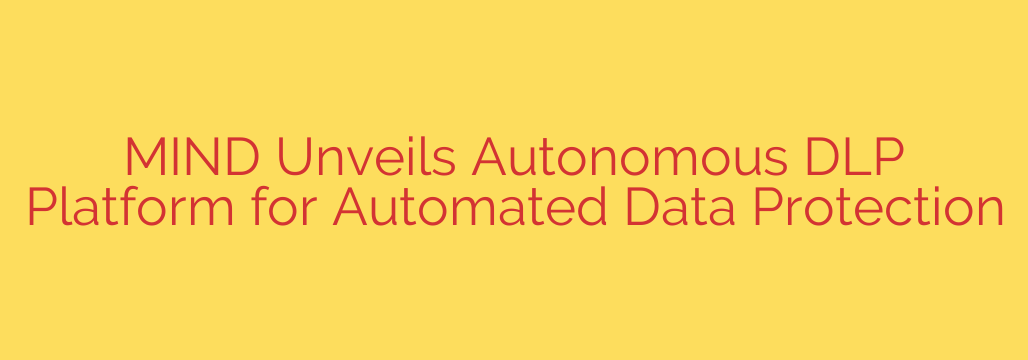
The Next Evolution in Cybersecurity: Why Autonomous DLP is a Game-Changer for Data Protection
In today’s digital landscape, data is both an organization’s most valuable asset and its biggest vulnerability. The sheer volume of sensitive information—from customer records and intellectual property to financial data—is staggering. Protecting this data from leaks, theft, and accidental exposure is a top priority for security teams, but traditional methods are struggling to keep up.
The challenge lies in the complexity and manual effort required by conventional Data Loss Prevention (DLP) systems. Now, a new approach is emerging that promises to revolutionize how we secure our critical information: Autonomous DLP. This isn’t just an incremental update; it’s a fundamental shift from manual oversight to intelligent, automated data protection.
The Problem with Traditional Data Loss Prevention
For years, DLP has been a cornerstone of enterprise security. However, legacy solutions often create as many problems as they solve. Security professionals are all too familiar with the common frustrations:
- Constant Manual Tuning: Traditional DLP relies on administrators writing and constantly updating complex rules and policies. As new data types emerge and business processes change, this becomes a never-ending cycle of manual adjustments.
- Overwhelming Alert Fatigue: These rule-based systems often generate a high volume of false positives, flooding security teams with alerts that aren’t real threats. This noise makes it easy to miss the genuine incidents that require immediate attention.
- Inability to Understand Context: A classic DLP system might flag a file containing keywords like “financial report,” but it can’t easily distinguish between a CFO sending a legitimate report to the board and an unauthorized employee trying to exfiltrate the same file to a personal cloud drive.
- Struggles with Unstructured Data: Much of an organization’s most sensitive data exists in unstructured formats like documents, presentations, source code, and design files. Manually classifying and protecting this massive, ever-growing pool of data is nearly impossible.
These limitations mean that security teams spend more time managing their tools than actively protecting data, leaving significant gaps for potential breaches.
What is Autonomous DLP? A New Paradigm in Data Security
Autonomous DLP leverages the power of Artificial Intelligence (AI) and Machine Learning (ML) to protect data without the need for constant human intervention. Instead of relying on rigid, pre-defined rules, an autonomous platform learns and adapts to an organization’s unique data environment.
Think of it as the difference between a simple traffic camera that tickets every car going over 60 MPH and an intelligent traffic system that analyzes flow, intent, and conditions to prevent accidents before they happen.
An autonomous system works by continuously and automatically:
- Discovering and Classifying Data: It scans all data repositories—on-premise servers, cloud applications, and endpoints—to find sensitive information, even if it’s not labeled.
- Understanding Context and User Behavior: The AI engine learns how data is normally used within the organization. It builds a baseline of normal activity for every user, department, and data type.
- Making Intelligent, Real-Time Decisions: By combining data classification with behavioral context, the platform can accurately identify high-risk actions. It understands the “who, what, where, when, and why” behind every data interaction.
- Automating Policy Enforcement: When a genuine threat is detected—such as an unusual attempt to copy, move, or share sensitive data—the system can automatically apply the correct security policy to block the action, encrypt the data, or alert an administrator.
The Key Benefits of an Autonomous Approach
Adopting an autonomous DLP strategy provides significant advantages that directly address the failings of older systems.
- Drastically Reduced Manual Workload: By automating discovery, classification, and policy enforcement, autonomous platforms free up security teams from tedious manual tasks. This allows them to focus on strategic security initiatives rather than chasing down endless alerts.
- Unprecedented Accuracy and Fewer False Positives: Because AI-driven decisions are based on deep contextual understanding, the rate of false positives plummets. When an alert is generated, it’s far more likely to be a real, actionable incident.
- Adaptive and Continuous Protection: The business world isn’t static, and your data protection shouldn’t be either. An autonomous system continuously learns and adapts to new applications, new types of sensitive data, and evolving user behaviors, ensuring protection keeps pace with the business.
- Complete Data Visibility: You can’t protect what you can’t see. Autonomous DLP provides a comprehensive, unified view of all sensitive data across the entire organization, eliminating dangerous blind spots in the cloud or on remote devices.
Actionable Steps to Modernize Your Data Security
Moving toward a more automated and intelligent data protection strategy is essential for survival in the modern threat environment. Here are a few key steps to consider:
- Audit Your Current Processes: Evaluate how much time your team spends on manual policy creation and alert investigation. Identifying these bottlenecks will highlight the clear value of automation.
- Prioritize Context Over Keywords: Shift your security mindset from simple pattern matching to understanding user intent and data context. The most significant risks often lie in unusual behavior, not just the presence of a sensitive keyword.
- Embrace AI-Powered Solutions: When evaluating new security tools, look for those that have a core of machine learning and automation. Any platform that still relies heavily on manual rule-writing is already a step behind.
- Focus on Proactive Prevention: The goal should be to stop data loss before it happens. An autonomous system that can predict and prevent a breach is infinitely more valuable than one that simply reports on it after the fact.
The future of data security is intelligent, adaptive, and autonomous. By moving away from the manual, labor-intensive models of the past, organizations can finally achieve a state of continuous data protection that is both more effective and more efficient.
Source: https://www.helpnetsecurity.com/2025/08/06/mind-dlp-platform/








